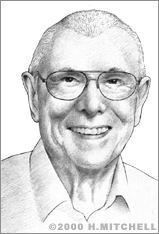Leonard Cutler
Leonard Cutler was a pioneer in the field of ultraprecise timekeeping standards and devices for over forty years.
Cutler was a veteran of the greater Silicon Valley scientific community. He earned his BS (1958), MS (1960), and PhD (1966) in Physics from Stanford University, all while working at neighboring Hewlett-Packard Laboratories. The mainstay of Cutler's work at HP had been developing atomic frequency standards and designing atomic chronometers.
One sub-specialty of nuclear physics that emerged early was the observation and measuring of the constant rate at which atomic matter emits radiation or "vibrates" between states. As scientific experiments became ever more subtle, scientists required more precise means to measure the passage of time. It was a natural progression that atomic clocks were developed. Atomic clocks are electric clocks whose timing is regulated by atomic decay. For example, a clock regulated by the radiation of hydrogen loses only one second every 1.7 million years. The most common isotope (133) of cesium, the most electropositive of the elements, became the element of choice for such clocks.
The first atomic clock was invented in 1948. In the early 1960s, HP set out to design a cesium clock for commercial purposes. In 1964, Cutler and his colleague Al Bagley succeeded, inventing the HP5060A Cesium Beam Clock. This was the first all-solid state cesium-beam chronometer, whose frequency standard was soon adopted by the U.S National Institute of Standards and Technology and other scientific centers around the world. Cutler's 1964 clock coordinated international time to within a microsecond, whereas previous efforts had pared accuracy down to only a millisecond.
Cutler continued refining both the design and the constituent parts of cesium clocks, as well as researching in quantum mechanics. His most recent triumph, in 1991, was the HP 5071A. At twice the accuracy of its predecessor, it remains the world's most accurate commercial clock, losing about one second every 1.6 million years. The HP 5071A also accounts for 82% of the data that is relied on to keep the International Atomic Time Standard.
Cutler has earned a number of patents, alone and on teams, for various atomic devices. His major invention outside the immediate realm of chronometry has been the two-frequency laser inferometer, which has become an essential element of integrated circuit manufacturing.
Leonard S. Cutler was well known in the U.S. and abroad as an authority on atomic timekeeping and quantum-mechanical effects. His many honors include the IEEE's Centennial Award (1984) and the American Institute of Physics' Industrial Applications of Physics Award (1993). In 1990, Cutler became HP's first Distinguished Contributor. In that capacity, Cutler worked at Agilent Technologies, an HP spin-off, developing atomic clocks and quartz oscillators and using the Global Positioning System to synchronize clocks worldwide. Agilent Technologies named him their first Distinguished Fellow in 2004. He died on September 5, 2006.


